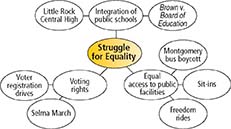CHAPTER 27: Quick Study Guide
Progress Monitoring Online
For: Self-test with vocabulary practice
Web Code: nea-1410
- Struggle for Equality
- Civil Rights Legislation
Civil Rights Act of 1964 - Banned segregation in public accommodations
- Increased federal authority to enforce school desegregation
- Outlawed discrimination in employment on basis of race, color, and sex
Twenty-fourth Amendment (1964) - Eliminated poll tax as voting requirement
Voting Rights Act of 1965 - Banned literacy tests as voting requirement
- Empowered the federal government to supervise voter registration and elections
Fair Housing Act of 1968 - Banned discrimination in housing
- Civil Rights Organizations
Organization and Date Founded Key People Key Features National Association for the Advancement of Colored People (NAACP) 1909 Thurgood Marshall Focused on legal cases to end segregation and gain legal equality Nation of Islam 1930 Elijah Muhammad; Malcolm X Advocated separation of the races Congress of Racial Equality (CORE) 1942 James Farmer Organized peaceful protests to gain civil rights Southern Christian Leadership Conference (SCLC) 1957 Martin Luther King, Jr.; Ralph Abernathy Church-based group dedicated to nonviolent resistance; organized demonstrations and protest campaigns Student Nonviolent Coordinating Committee (SNCC) 1960 James Lawson; Ella Baker; Stokely Carmichael Grass-roots movement of young activists; organized voter education projects in the South Black Panther Party 1966 Huey Newton; Bobby Seale Militant group advocating armed confrontation; organized antipoverty programs
 Quick Study Timeline
Quick Study Timeline
For: Interactive timeline
Web Code: nep-1412






